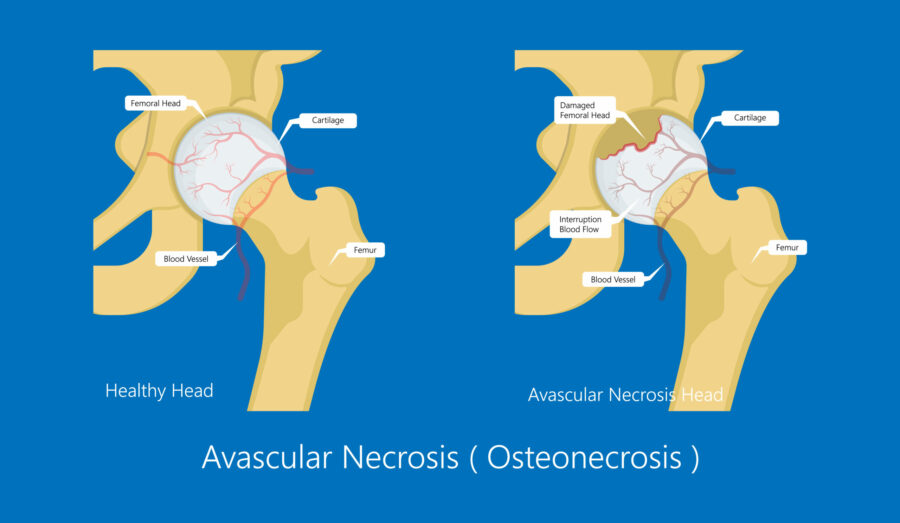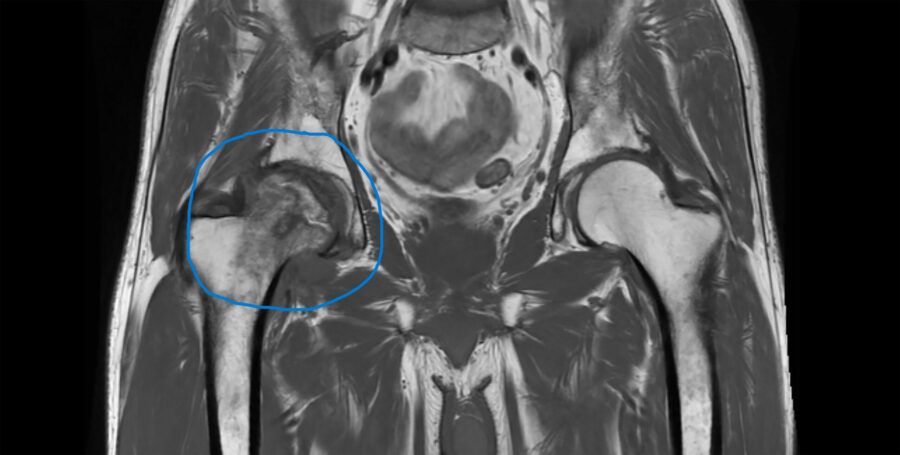AVN is a progressive condition which means that without treatment, it will continually get worse.
Avascular necrosis (AVN) is a medical condition that happens when there is very little, or no blood supply to your bone. As a result, parts of your bone tissue may deteriorate, break away and die. AVN can affect any bone in your body, but is most common in the bones near your joints and the hip joint is the most common joint affected.
Children and adults can be affected by avascular necrosis.
What causes AVN?
The cause of AVN is a lack of blood getting to your bones. As a result, your bones don’t get the nutrients they need to stay healthy or repair themselves, so they slowly deteriorate and die.
What increases my risk of AVN?
There are different things that can increase your risk of developing AVN. Some may be related to your lymphoma, and some may be completely unrelated to your lymphoma. See the list below for lymphoma related, and non-cancer related causes of AVN.
Potentially lymphoma related causes of AVN
- Long-term use of high-dose corticosteroids
- Radiation therapy
- Chemotherapy
- Certain medical treatments like bone marrow biopsy or bone grafting.
Other potential causes of AVN
- Trauma or injury to the affected bone
- Drinking too much alcohol
- Blood clotting disorders
- High cholesterol
- Organ transplantation
- Decompression sickness (commonly known as “the bends”)
- Some medical conditions like lupus, sickle cell anemia, and HIV/AIDS
Symptoms of AVN
Symptoms of AVN can range from no noticeable symptoms to severely debilitating pain and loss of movement in the affected joints.
Some symptoms may be harder to notice because they come on slowly and gradually get worse over a long period of time. While for some you, the symptoms may happen very quickly.
If you have ever had any of the above risk factors and notice:
Pain that feels like it is coming from your bones or joints, especially if it is suddenly severe pain, or if it keeps getting worse.
Stiffness, or difficulty moving your joints (the area where 2 bones meet) which can include your hips, shoulder, knees, elbow, knuckles or other areas.
Weakness in your muscles or joints which may make it harder, or impossible to walk, hold your weight or pick things up and hold them.
Changes to the shape of your joints.
How is AVN diagnosed?
You may be diagnosed with AVN after you go to the doctor for pain or stiffness in your joints or after you have scan for some other reason. If your doctor thinks you have AVN or another condition affecting your joints they will:
- Ask you about your medical history to see if you have any risk factors for AVN.
- Do a physical examination of your painful or stiff joints to check how well they move, and if any movement or touch makes them more painful.
- Order imaging tests such as X-Ray, Bone scan, CT or MRI scan.
- May order blood tests.
How is AVN treated?
Your treatment for AVN will depend on how severe the damage to your bones and joints is, your symptoms and your personal preference.
Early stage AVN
If you AVN is its early stages with only limited damage to your bone you may be treated with:
- Physiotherapy to improve your movement and strengthen your surrounding muscles and joints.
- Medicine to ease any pain. These may include Panadol osteo or anti-inflammatory medicine such as ibuprofen (Nurofen) or meloxicam.
- Rest to limit the weight on the affected joint. For example, you may need to use crutches so you can still walk but keep the weight off the affected side.
- Cold or hot packs for comfort and pain relief.
- Medicine to clear any blood clots affecting the blood flow to your bones.
- Electrical stimulation which can be done by a physiotherapist may help improve blood flow to your bones.
- Medicine and diet to lower your cholesterol if high cholesterol is thought to be causing, or making your AVN worse.
Advanced stage AVN
If your AVN is more advanced, or the above treatments do not work to improve your symptoms you may need stronger pain medicine and surgery. You will likely be referred to an orthopedic surgeon, which is a doctor who specialises in performing operations involving the bones. You may also be referred to a vascular surgeon who is a doctor that specialises in performing operations involving the blood vessels.
Types of surgery
The type of surgery you have will depend on your individual circumstances but may include a replacement of the affected joint or a bone graft, where your bone is removed and replaced with a donor bone or artificial bone. Your surgeon will be able to explain the best type of surgery for you.
If there is a blockage in your blood vessels stopping the blood from getting to your bones, you may have surgery to clear the blockage.
Pain relief
In the lead up to surgery you may need to have strong pain medication to help you cope while waiting for surgery. These may include opioid medicines like oxycodone or tapentadol. These medicines may also be needed for a short time after surgery.
Ongoing physiotherapy
In the lead up to, and after surgery you should see a physiotherapist. They will be able to help you with your movement before and after surgery.
What other support is available?
You may need extra support if your AVN is making it difficult for you to manage at home or work.
Occupational therapist
Ask your local doctor (GP) to do a GP management plan with you to look at what your needs may be, and to link you in with different services available in your area. An occupational therapist can visit your home and/or work to see what changes may make it easier for your to do the things you need to while protecting your joints affected by AVN and preventing or limiting pain with those activities. They can also help with getting you special equipment to help you keep as independent as possible.
Pain specialists
Pain specialists are doctors, nurses and other health professionals who look after patients with complex and difficult to treat pain. They may be useful to you, if your pain is not improving. Your GP can refer you to a pain service.
Community organisations
Community organisations may be able to help with managing housework, gardening, shopping and other activities you struggle with as a result of your AVN. Your GP can refer you to these services as part of the GP management plan.
Summary
- Avascular necrosis (AVN) is a rare complication that can happen after treatment for lymphoma, or if you have other risk factors.
- AVN can range from mild to severe pain and loss of movement in the bones and joints affected.
- Physiotherapy can help you improve or maintain movement in the affected areas while occupational therapy can look at how to make your home or work environment easier for you to work or live in.
- If you have severe pain or disability from the AVN, you may need to be referred to a pain specialist or surgeon for further management and treatment.
- Ask your GP to do a GP management plan to help coordinate all the care you may need with managing or treating AVN.



